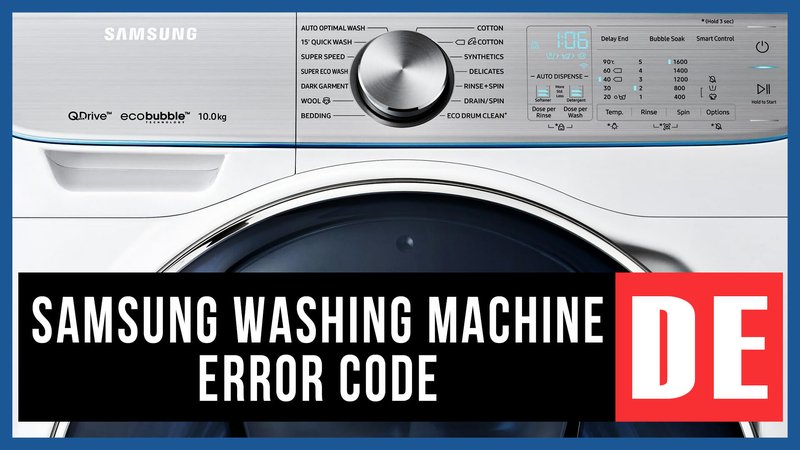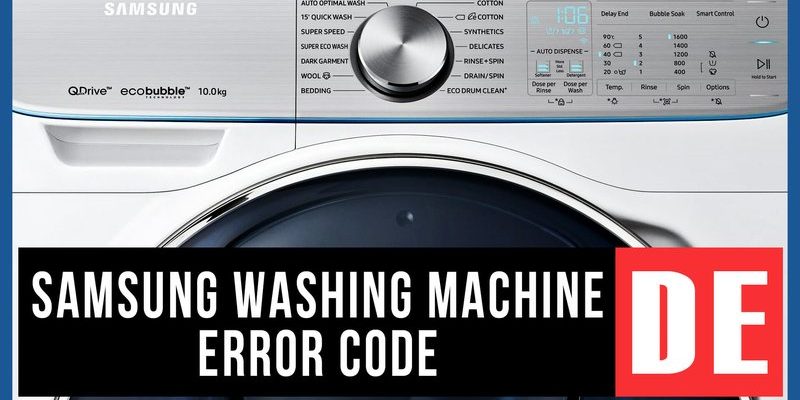
An error code on your washing machine is a bit like your car’s check engine light. It’s there to alert you that something isn’t quite right under the hood. The “OE” error code signals an issue with the machine’s ability to drain water. You might not be a washing machine expert, but you don’t need to be. This piece of information is important because it allows us to tackle the problem head-on, rather than standing in front of the machine scratching our heads.
Understanding the OE Error Code
The “OE” error code on a Samsung washing machine is a signal that your machine is experiencing drainage problems. Think of your washing machine as having a stomach—it tries to process things through, but sometimes things get stuck. This particular error means that the water is not being expelled out as efficiently as it should be. The causes can vary, from a kinked drain hose to a clogged filter that is preventing the effective removal of water from the drum.
This error might seem daunting at first, like trying to unravel a complicated knot. But in reality, understanding the reason behind it is like knowing that a flat tire can often be fixed with a patch. OE errors can occur due to simple blockages, which might be solved by removing any debris or lint that’s causing a stoppage.
So, you might be wondering: will pressing that reset button solve the issue? Well, resetting the machine is a bit like rebooting your computer when it freezes. It can sometimes help the machine to resync, clearing minor glitches. But, just like a computer, if the underlying issue isn’t addressed, the problem is likely to recur.
Resetting Your Samsung Washing Machine
So, when faced with the OE error, your first instinct might be to hit reset. Now, what does that mean for a washing machine? It’s like giving it a fresh start or a moment to catch its breath. It involves powering down the machine, waiting for a few minutes, and then turning it back on. This process, akin to a reboot, can help clear temporary issues or software glitches.
Here’s the deal: while resetting might clear the error temporarily, it doesn’t address the root cause. If your drain hose is kinked or blocked, or if your filter is clogged, the error is likely to reappear. Resetting can be useful if the machine’s sensors have malfunctioned and need a reset to function correctly, but it can’t remove physical blockages.
However, don’t discount the power of a reset entirely. If your machine throws an OE code sporadically and all hardware seems fine, a reset might resolve the issue. Picture it as blowing on a video game cartridge back in the day – sometimes all it needed was a little nudge to work properly again.
When to Call for Help
If the OE error persists despite all your troubleshooting, it may be time to call in the cavalry – a professional technician. Just like you’d see a mechanic for a stubborn car issue, a professional has the right tools and knowledge to diagnose and fix the problem accurately. They can check deeper into the machine’s plumbing, electronic controls, and other areas that might not be immediately visible.
But before making that call, double-check a few things at home. Confirm that the drain hose isn’t kinked or blocked and that the filter is clean. These are common culprits and often some of the easiest things to fix. A little DIY spirit can save time and money, and there’s a certain satisfaction in solving the problem yourself.
For ongoing issues, keeping a maintenance log can be helpful. Note down when errors occur and any steps you take to fix them. This can provide a useful history for both you and any technician you might involve. It’s like keeping a medical record for your washing machine—knowing its history can make diagnosis faster and repairs more efficient.
Preventing the OE Error Code
As the saying goes, an ounce of prevention is worth a pound of cure. Preventative steps can minimize the chances of encountering the OE error. Regularly cleaning your washing machine’s filter and checking the drain hose for blockages keep it running smoothly, just like regular oil changes keep a car engine happy.
You can also run a maintenance cycle with vinegar or a washing machine cleaner to help remove any buildup in the drum and drainage system. Use the right detergent in the correct amount, as too much soap can lead to an overflow of suds, impacting the machine’s drainage efficiency. Finally, make sure to load the washing machine properly according to the manufacturer’s guidelines, as an overloaded machine can struggle to drain effectively.
Keep in mind, consistent care and attention can extend the life of your appliance and reduce the chances of encountering unpleasant surprises like error codes. Regular maintenance is like brushing and flossing for your machine—it’s the key to long-term health.
In short, while resetting your Samsung washing machine might provide a temporary fix for the OE error code, addressing the underlying issues is crucial for a permanent solution. By understanding the cause and taking preventative measures, you can ensure your appliance stays in top shape.
